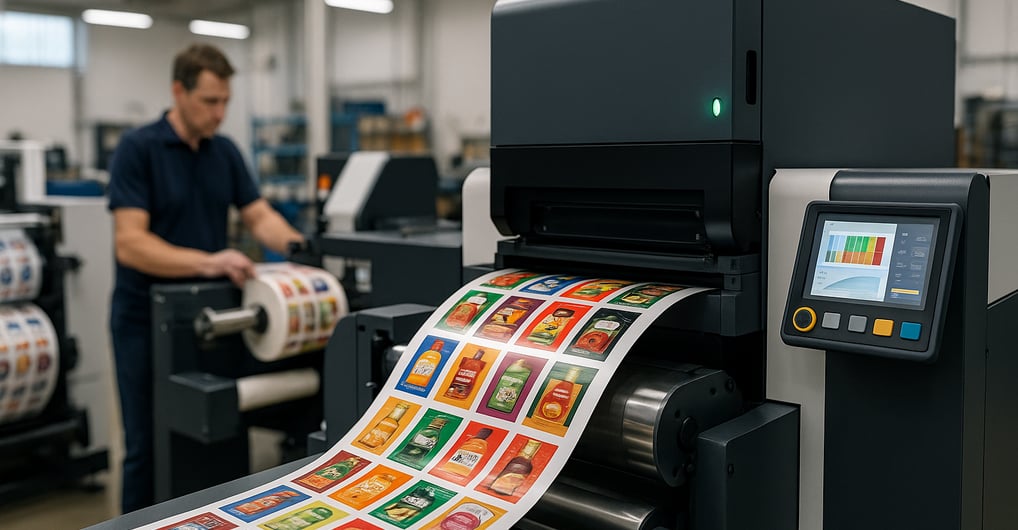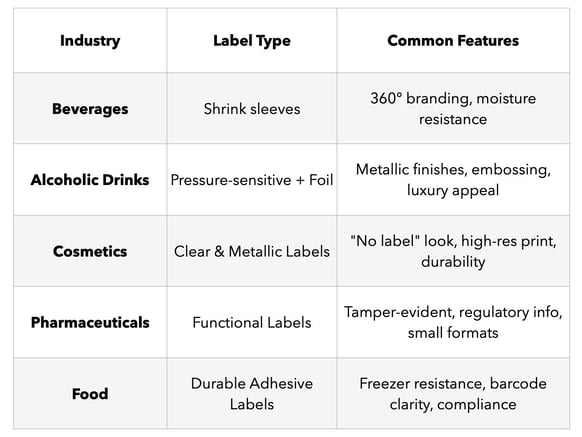Labels. Profits. Possibilities.
Explore how digital commercial printers can unlock high-margin growth by entering the booming digital label printing space. This blog breaks down technology choices, industry-specific label needs, startup strategies, and how inkjet presses with CMYK+White can expand your market reach—without the need for heavy investment or skilled flexo operators. A must-read for growth-minded printers in developing markets.
PRINTINNOVATIONPRINTECONOMICSINKJETPRINTING
Aaseem A Kulkarni
5/5/20253 min read


Introduction
If you're a digital printer wondering what comes next—this is it.
The world is no longer just about business cards, brochures, and flyers. It’s about brands, packaging, and storytelling—and labels are right at the heart of it all.
As global demand for shorter runs, custom packaging, and fast turnaround explodes, one print segment is stealing the spotlight: digital label printing.
For years, label production was the domain of large flexo houses. Not anymore. Today, with the right digital technology, you can print stunning, high-value labels—on demand, with minimal setup, and without breaking the bank. And guess what? Your current digital press operators can run it. No flexo veterans needed.
In this blog, you'll discover how:
The digital label market is booming with real, bankable opportunities.
Labels differ by industry—and how that opens up niche plays.
Inkjet (yes, we’ll explain why) is your best bet for starting strong.
You don’t need expensive inline embellishment gear to begin.
You can finally move from “printer-for-hire” to value-added label partner.
Ready to go beyond pages and into packaging? Let’s dive in.
The Label Printing Boom: Big Opportunity, Small Risk
The global label printing market is worth $49.2 billion and growing at 6.7% CAGR (source).
Even better? Digital label printing is outpacing flexo, growing at over 13% annually (source).
Why? Because the world needs:
Shorter runs
Variable data
Faster turnarounds
Personalized packaging
Flexo just can’t keep up with all that. But digital? It was built for this. And in developing markets, where budgets are tight and agility matters, digital is a dream come true.
Digital vs. Flexo: Who Wins Where?
Flexo is amazing—for high volumes and standardized jobs. It supports:
A wide variety of substrates
Inline embellishments
High-speed long runs
But here’s the catch: it needs plates, skilled operators, longer setup times, and high order quantities to be cost-effective.
Digital printing, on the other hand:
Requires no plates or setup costs
Delivers quick changeovers and variable content
Supports short to medium runs with profitability
Can be run by your existing commercial digital team
Result? Digital dominates in flexibility, speed, and total cost of ownership for dynamic label work.
Know Your Customer: Who Uses Digital Labels?
If you thought labels were only for big brands, think again.
Digital labels are being used by:
Startups and home-grown product brands
D2C (direct-to-consumer) sellers
Boutique and export businesses
Pharmacies and nutraceutical companies
E-commerce packaging vendors
These customers want:
Low quantity, high quality
Quick revisions
Unique branding
And they’re willing to pay more per label for the value digital brings. These are the customers you already serve in commercial print—now it's time to serve them better with labels.
Label Types by Industry: What’s Out There?
Not all labels are created equal. Different industries demand different looks, finishes, and performance.
Understanding this helps you decide:
Which market(s) to target
What substrates and finishes you’ll need
What post-press equipment is worth investing in
Understanding Your Tech Options
So what kind of digital label presses are out there? Let’s break them down:
Inkjet
High image quality
UV or water-based inks
Great for textured, metallic, and synthetic substrates
Lower long-term running costs
Most versatile and scalable
Dry Toner (Powder)
Good for fine text and CMYK accuracy
Limited substrate options (needs pre-coated)
Less suitable for embellishments
Liquid Toner
Offset-quality reproduction
Complex and expensive
High maintenance, limited supplier ecosystem
Our take? Inkjet wins hands down for commercial printers making their move into labels.
What You Need (and What You Don’t)
You do NOT need to invest in:
Expensive inline varnishers
Complex embellishment lines
High-speed flexo-finishing
Instead, start with the core and build smart:
A digital label press with CMYK + White (White expands your customer base by 30-40% instantly! Think clear and metallic substrates.)
Offline embellishment: cold foil, spot UV, lamination
Basic slitter-rewinder to finish rolls
You can scale up later—for now, get in the game.
Common Challenges (And How to Beat Them)
Substrate access: Partner with regional label stock suppliers or import basics in bulk.
Customer education: Show clients samples of embellished and short-run labels.
Color matching: Use good RIP software and ICC profiling.
Volume fear: Many clients don’t need 50,000 labels. They need 500—1000. Be their go-to guy.
Why This Move Makes Total Sense
Here’s the truth:
Digital label printing is growing faster than commercial printing.
Label customers need faster service, smaller batches, and more versions.
You already have the infrastructure and the talent—no need to retrain.
You don’t need a flexo expert. You need vision.
Digital labels let you move from being a job taker to a solution provider. And when you do that? You print less, earn more, and grow faster.
Final Word
Labels. Profits. Possibilities. They’re waiting. Let’s go.
Sources
Label Printing Market Report - Globe Newswire
Packaging Strategies - Digital Label Market Share
UPM Raflatac - Label Applications
Printing News - Importance of White Ink

